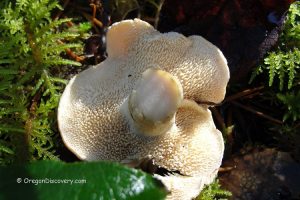
• King Bolete is the most prized wild mushroom all around the world
• This fungus is the safest wild edible mushroom for novices
King Bolete (Boletus edulis) and Spring King Bolete (Boletus rex-veris) are the most prized wild mushrooms all around the world with excellent nutritional properties. The gourmet edible mushroom is known as Porcini in Italy, Penny Bun in England, Cep in France, Steinpilz in Germany, and Borovik in Russia. This is one of the best edible mushrooms with a meaty texture, great aroma, and taste.
It is estimated that over 100,000 metric tons of King Bolete mushrooms are consumed worldwide annually. The cost of boletes is high because these fungi are restricted to wild foraging and tend to be the most difficult to cultivate.
King Bolete may vary in color, shape, size, and habitat. The chef's favorite mushrooms have been used in various recipes. They are great for drying, sautéing, frying, or pickling.
This fungus is the safest wild edible mushroom for novices. These mushrooms are easy to identify by their appearance and spongy-like surface underside of the cap. Check main points of King Bolete's identification on to avoid lookalikes that can be bitter or even toxic.
Important:
- Avoid boletes with red or orange pores and flesh that bruises blue or black
- If you aren’t certain, avoid boletes with yellow pores that bruise blue
- If you aren’t absolutely sure it is edible, avoid orange-capped boletes with yellow pores that bruise blue
- Break of a small piece of mushroom, taste it (do not swallow). If it is bitter or sour, do not take it.
Attention: This technique can be used for boletes only. Absolutely, do not use it for other species of mushrooms.
Cautions. Boletes like many other mycorrhizal fungi absorb toxic heavy metals such as lead and neodymium from the soil. Avoid the polluted areas near metal mines, industrial buildings, or busy highways.
Where and When to Find King Boletes in Oregon
Most boletes are found on the ground in wooded areas and at their edges, under conifers (pine, western hemlock, Sitka spruce) and hardwoods (oak, birch, aspen).
Springs King Boletes (Boletus rex-veris) grow under Ponderosa pines and white firs at higher elevations of 3,000 feet above sea level and higher. These mushrooms are found in mountain forests of Cascades and fruit from May through June when the soil is saturated after snowmelt or winter rain and the air temperature is warming up. Springs Kings fruit after the black morels (April-May) and there is a chance you find both species at the same time.
The Fall Porcini season, typically, continues from September to November, after heavy rainfalls to first frosty nights. The fungi are widely distributed in the coastal forests and parks, the Coast Range, and the Cascade Mountains. Often King Bolete co-existes with Amanita Muscaria, so the brightly colored poisonous amanita is a great indicator of the porcini presence.

Cap: Large, bun-shaped becoming nearly flat when mature. Smooth surface, pale to red- or dark-brown, 3-10 inches (8-25 cm) wide.
Cap's Underside: Sponge-like, rounded pores are white when young and yellow-olive when mature, tubes are sunken around the stalk.
Spore Print: Elliptical, olive-brown.
Stem: Whitish to brownish. Thick and club-shaped, 4-10 inches (10-25 cm) long.
Flesh: Firm and solid, white.
Fruiting: Singly or in groups.
Habitat: Mycorrhizal with conifer trees: pine, western hemlock, Sitka spruce. Most likely found in the new-growth forest.
Season: Early summer to late fall.
Nutrition Facts
Bolete is a great source of dietary fiber, protein, and minerals such as selenium, manganese, zinc, and copper. Also, this fungus contains Vitamins D, C, B, ergothioneine, glutathione, flavonoids, and phenolic compounds. The presence of these compounds possesses a number of health benefits.
According to Penn State University research, the abundant amounts of antioxidants, ergothioneine, and glutathione in boletes may help to protect the body against illnesses in older age, including cancer, coronary heart, Alzheimer’s, and Parkinson's diseases.
Professor Robert Beelman said, ".. you can see that countries like France and Italy that have more ergothioneine in their diets, also have lower incidences of neurodegenerative diseases, while people in countries like the United States, which has low amounts of ergothioneine in the diet, have a higher probability of diseases like Parkinson's Disease and Alzheimer's...the difference between the countries with low rates of neurodegenerative diseases is about 3 milligrams per day, which is about five button mushrooms each day."
Ergothioneine and glutathione are heat stable and cooking mushrooms do not significantly affect the compounds. Additionally, bolete is low in fat (saturated and unsaturated) and calories.

Methods of Cooking
Methods of cooking include stir-frying, sautéing, drying, pickling, preserving, and freezing.
Sautéing
Carefully clean boletus using a small knife. Gently wipe the cap surface and steam with a paper towel. If they must be washed, fill a container with water, rinse mushrooms quickly, so they do not absorb too much water. After cleaning, slice up the fruit bodies. If the sponge layer is soft and watery, removed it before cooking.

- Heat a large skillet over medium-high heat
- Add butter (you can use olive oil)
- When the butter is melted, add sliced boletes
- Sauté them for about eight to ten minutes
- Add onion, sprinkle with sea salt to taste (and pepper if you like)
- Continue sautéing another five minutes
- You can add 2 tablespoons of white wine
- Stir them and cook until liquid is reduced.
You May Also Enjoy
Disclaimer
This is not an official guide to wild mushroom foraging. Please, do your own research, be sure to practice with a mushroom expert before you pick up and consume any wild mushrooms. Before you get started wild mushroom harvesting, learn to accurately identify poisonous mushrooms as well. All wild edible mushrooms must be thoroughly cooked. Make sure that you are not allergic to a new mushroom by trying a small amount before eating more.












